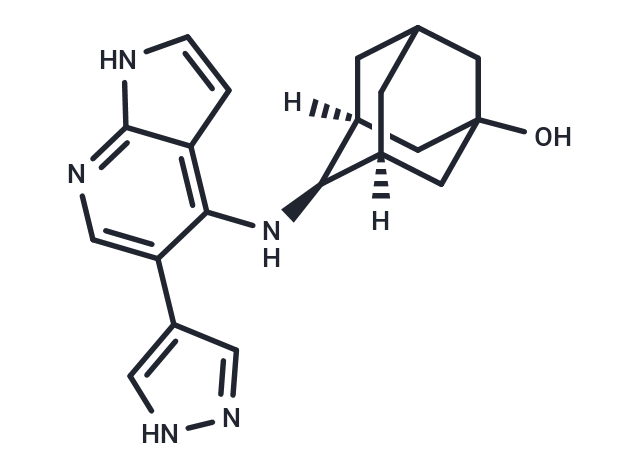Shopping Cart
- Remove All
 Your shopping cart is currently empty
Your shopping cart is currently empty

JAK1-IN-12, a selective inhibitor of JAK1, exhibits an IC50 of 0.0246 μM and demonstrates IC50 values of 0.423 μM, 0.410 μM, and 1.12 μM for JAK2, JAK3, and TYK2, respectively. It promotes hair growth in mice and is applicable for researching immune and inflammatory diseases [1].

| Pack Size | Price | Availability | Quantity |
|---|---|---|---|
| 10 mg | Inquiry | 10-14 weeks | |
| 50 mg | Inquiry | 10-14 weeks |
| Description | JAK1-IN-12, a selective inhibitor of JAK1, exhibits an IC50 of 0.0246 μM and demonstrates IC50 values of 0.423 μM, 0.410 μM, and 1.12 μM for JAK2, JAK3, and TYK2, respectively. It promotes hair growth in mice and is applicable for researching immune and inflammatory diseases [1]. |
| Targets&IC50 | JAK3:0.410 μM, JAK1:0.0246 μM, JAK2:0.423 μM |
| In vitro | HDAC-IN-57 (Compound 12b) inhibits JAK1 and JAK2 in Ba/F3-TEL-JAK1 cell lines, with IC50 values of 0.110 μM and 6.105 μM, respectively [1]. At a concentration of 1 μM, HDAC-IN-57 (Compound 12b) exhibits strong interactions with JAK1, JAK3, PKD2, HPK1, and AurB in kinase panel assays [1]. |
| In vivo | JAK1-IN-12 (Compound 12b) was administered as a 2% solution in 10% DMSO, applied daily for one month, to 8-week-old C57/B6 mice to enhance hair growth in the shaved dorsal back region [1]. Animal Model: C57/B6 mice [1] Dosage: 2% in 10% DMSO solution Administration: Topical application; daily for 1 month Result: Induced skin darkening within 9 days and stimulated new hair growth within 13 days. |
| Molecular Weight | 349.43 |
| Formula | C20H23N5O |
| Cas No. | 2945204-95-3 |
| Storage | Powder: -20°C for 3 years | In solvent: -80°C for 1 year | Shipping with blue ice. |

Copyright © 2015-2025 TargetMol Chemicals Inc. All Rights Reserved.